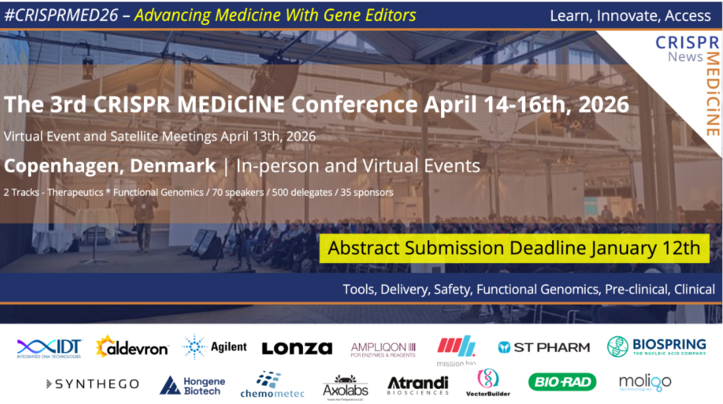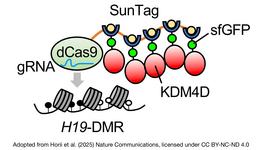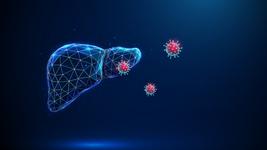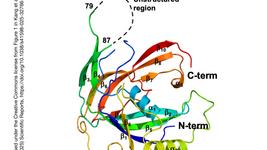CMN Weekly (19 September 2025) - Your Weekly CRISPR Medicine News
By: Gorm Palmgren - Sep. 19, 2025
Top picks
- Researchers at Sangamo Therapeutics have engineered a Modular Integrase (MINT) platform by reprogramming the serine integrase Bxb1for precise, protein-guided DNA integration at endogenous genomic sites without pre-installed target sequences. Using structural modelling, directed evolution and fusion with zinc fingers, they achieved up to 35% targeted integration at the TRAC locus and 15% stable integration in human T cells, underscoring its therapeutic potential.
- The same Bxb1 serine integrase has also been employed by German scientists who developed ‘one-pot’ PASTA, a non-viral method combining CRISPR-Cas HDR with serine integrases for efficient large transgene integration in T cells. Using Bxb1, they achieved up to 19-fold higher efficiency than HDR and 5-fold over PASSIGE for constructs >8 kb. The approach enabled complex CAR T designs, including dual-antigen targeting with a safety switch, offering a scalable strategy for advanced cell therapies.
Research
- Engineered U snRNAs has been shown to enable precise RNA-level editing, enhancing adenosine-to-inosine conversion with fewer off-targets and persistent nuclear activity. They also edit splice sites and long noncoding RNAs, while fusion constructs drive targeted pseudouridylation, rescuing CFTR expression in cystic fibrosis cells. This work establishes snRNAs as a versatile platform for programmable RNA editing without altering DNA.
- Spanish researchers have used CRISPR-Cas9 to engineer human cord blood CD34⁺ HSPCs to model the haematologic, immunologic and vascular disorders collectively known as GATA2 deficiency. They demonstrate that the R398W variant impairs stem cell fitness through mitotic dysfunction and premature ageing, effects that are not rescued by cooperating oncogenic mutations.
- Scribe Therapeutics has unveiled DeepXE, an AI-driven CRISPR design platform that predicts editing efficiency for its engineered CasXE editors. DeepXE achieved >90% sensitivity, halved screening size, and doubled hit rates with <10% false negatives, outperforming Cas9-based models. Its robust generalisability across XE variants and targets accelerates discovery of potent genome-editing therapeutics, enhancing precision and efficiency in Scribe’s pipeline development.
- German researchers have optimised a virus-free CRISPR protocol for iPSCs, using sequential delivery of Cas9 or Cas12a RNPs with donor plasmids to achieve >30% knock-in efficiency. The approach enabled creation of HLA class I–deficient iPSCs carrying an inducible caspase-9 suicide gene, with clones retaining genomic integrity and differentiation potential. This GMP-compatible method provides a flexible platform for safe, customised iPSC engineering in research and therapy.
- Researchers have developed a computational design method for small DNA-binding proteins (DBPs) that recognise specific short sequences with nanomolar affinity. By positioning modules using RFdiffusion, they achieved base-pair–level specificity and validated designs structurally and functionally in both E. coli and mammalian cells. These DBPs can repress or activate transcription, offering a new, deliverable platform for programmable gene regulation and editing.
- A new, engineered next-generation prime editor (vPE) destabilises competing 5′ strands through Cas9-nickase mutations, reducing indel formation. vPE maintains editing efficiency while achieving up to 60-fold fewer indels and edit:indel ratios of 543:1. This strategy overcomes a key limitation of prime editing, enabling more precise and reliable genome modifications.
- Using CRISPR activation (CRISPRa), researchers upregulated the functional SCN2A allele to counter haploinsufficiency in mice. AAV-delivered CRISPRa restored neuronal excitability, corrected synaptic deficits, and protected against seizures in Scn2a+/− models. Human stem-cell-derived neurons showed similar rescue. These findings demonstrate that gene upregulation therapy can reverse neurological phenotypes, even when administered at adolescent stages.
- Researchers used adenine base editing to correct a Pou4f3 nonsense mutation causing DFNA15 deafness. In a new mouse model, AAV-delivered SchABE8e restored precise editing efficiency up to 48.5% and enabled near-complete, durable hearing recovery lasting at least four months. Safety analyses confirmed feasibility, highlighting base editing as a promising therapeutic strategy for hereditary hearing loss.
- Using a dual-guide CRISPR-Cas9 library, researchers screened 472 predicted synthetic lethal pairs across 27 cancer cell lines, validating 117 interactions. They identified SLC25A28 as a promising target, given frequent loss of its paralog SLC25A37 in cancers. Knockout mice lacking Slc25a28 were largely normal aside from cataracts, suggesting minimal toxicity. This study expands the catalogue of actionable synthetic lethal interactions for cancer therapy.
- A stoichiometry-coded CRISPR-Cas strategy enables multiplex genotyping by assigning distinct crRNA quantities to generate separable fluorescence signals. Using a single tube, nuclease, and reporter, it achieved Brucella species identification and human ABO blood typing, with compatibility across PCR-, RAA-, and amplification-free formats. This approach provides a simple, scalable method for distinguishing pathogen and allele gene types in diverse applications.
Clinical and preclinical
- Intellia Therapeutics has completed enrolment in its Phase 3 HAELO trial of lonvoguran ziclumeran (lonvo-z), an in vivo CRISPR-Cas9 therapy targeting KLKB1 to prevent hereditary angioedema attacks. Topline data are expected in early 2026, with a planned BLA submission later that year and potential U.S. launch in 2027. Phase 1/2 data showed durable kallikrein suppression and major attack-rate reductions.
- Precision BioSciences reported early Phase 1 ELIMINATE-B trial data for PBGENE-HBV, an ARCUS gene-editing therapy targeting cccDNA and integrated HBV DNA in chronic hepatitis B. Multiple doses showed good tolerability and substantial HBsAg reductions, marking the first clinical evidence of this approach. Patient dosing has begun in Cohort 3, with further updates expected in 2025. Also read our in-deth take on the news here.
- Using a related strategy, Excision BioTherapeutics has reported preclinical success with EBT-107, a dual-guide CRISPR-Cas9 therapy targeting hepatitis B virus. In hepatocytes and mouse models, the approach excised large viral DNA fragments, reduced intrahepatic HBV DNA and biomarkers, and suppressed integration events linked to cancer risk. Importantly, no increase in chromosomal translocations or viral DNA integration was observed, supporting EBT-107’s safety and advancement toward clinical trials.
- Scribe Therapeutics has presented preclinical data on STX-1200, a CasXE-based therapy targeting the LPA gene to reduce lipoprotein(a). In transgenic mice, a single low dose achieved >90% Apo(a) knockdown with no detectable off-target edits, even at high exposure. This first proof-of-concept for CRISPR-based Lp(a) reduction highlights strong potency and specificity, positioning STX-1200 as a potential one-time therapy for cardiovascular risk.
Industry
- Vertex Pharmaceuticals has secured a reimbursement deal in Italy for CASGEVY, its CRISPR-Cas9 therapy for transfusion-dependent beta thalassemia and severe sickle cell disease. Italy, home to Europe’s largest TDT population (~5,000 patients), now joins several countries granting access. CASGEVY edits BCL11A in patient stem cells to boost fetal haemoglobin, reducing transfusions in TDT and vaso-occlusive crises in SCD.
- Arsenal Biosciences has cut 50% of its workforce, reducing staff to 127, as it restructures into a clinical-stage cell therapy company. The move follows a $325m Series C raise in 2024 and aims to extend cash runway while advancing lead CAR-T candidate AB-2100 in a Phase 1/2 trial for recurrent clear-cell renal carcinoma. Its Bristol Myers Squibb collaboration remains unaffected.
Detection
- Researchers have developed a one-pot asymmetric CRISPR assay for tuberculosis, achieving 5 copies/µL sensitivity within 60 minutes and detecting positives in as little as 15 minutes. In 603 clinical samples, it showed high sensitivity across respiratory, stool and CSF specimens, and outperformed reference tests with tongue swabs (74% vs 56%). Adaptable to lateral flow, it enables rapid, low-resource TB diagnostics.
- A new "LW probe" integrates Cas13a-triggered activation, entropy-driven amplification and a DNAzyme-powered DNA walker for rotavirus detection. This system achieves single-base mismatch discrimination and ultra-sensitive detection down to 2.7 fM, surpassing previous walker designs. By coupling precise target recognition with strong signal amplification, the approach enables robust, low-abundance viral detection, offering a promising diagnostic platform.
- EOD-CRISPR, combining helicase-assisted RPA with uAsCas12a, enhances reaction speed, sensitivity, and fluorescence, enabling one-pot multiplex detection. Lyophilised on a 3D-printed microfluidic disc with trehalose–glycine stabilisation, it allows simultaneous identification of four foodborne pathogens. Tested on contaminated food samples, the assay achieved sensitivities of 80–88.9% and specificities of 92.3–100%, rivalling PCR and offering a field-ready platform for onsite bacterial diagnostics.
Webinars and conferences
- A webinar on 22 October (11 am EDT) will introduce CRISPR base editing, focusing on cytosine and adenine editors. It will cover gRNA design, experimental planning and genotyping analysis, offering step-by-step guidance for implementing precise single-base edits without double-strand breaks. Hosted by Synthego’s Catherine Smith, the session targets researchers exploring safer, targeted genome modifications.
Reviews
- Exploring CRISPR/Cas: The Transformative Impact of Gene Editing in Molecular Biology. This review charts the progression of CRISPR-Cas from microbial defence to a versatile genome-editing platform, comparing it with earlier tools, outlining Cas enzyme innovations, and highlighting applications in disease modelling, diagnostics, and cancer immunotherapy.
News from CRISPR Medicine News
- On Wednesday, we dived into Precision BioSciences' first-in-human data for PBGENE-HBV, an ARCUS nuclease therapy designed to eliminate HBV cccDNA. In the Phase 1/2a ELIMINATE-B trial, all low-dose patients showed 47–69% HBsAg reductions, with one maintaining durable suppression for seven months. Treatment was well tolerated, with only mild flu-like events and no hepatotoxicity. Responses suggest combined direct editing and immune reactivation, supporting further dose optimisation and combination strategies.
To get more CRISPR Medicine News delivered to your inbox, sign up to the free weekly CMN Newsletter here.
“The European Genomic Medicine Consortium is quietly gathering under the CMN umbrella. Exploring the frontier of gene editing for therapeutic precision - this network is not public yet, but it’s real. Watch the signals, track the sequences. Only those who search will know.”R
Tags
ArticleNewsCMN WeeklyExcision BioTherapeuticsIntellia Therapeutics, Inc.Precision BioSciences, Inc.Sangamo Therapeutics Inc.Scribe TherapeuticsVertex Pharmaceuticals, Inc.
CLINICAL TRIALS
IND Enabling
Phase I
Phase II
Phase III
Gastric Cancer and Colorectal Cancer, CRC, (NCT07166263)
Sponsors:
Base Therapeutics (Shanghai) Co., Ltd.
Sponsors:
Base Therapeutics (Shanghai) Co., Ltd.
IND Enabling
Phase I
Phase II
Phase III
Relapsed or Refractory Acute Myeloid Leukemia, AML, (NCT06541444)
Sponsors:
Base Therapeutics (Shanghai) Co., Ltd.
Sponsors:
Base Therapeutics (Shanghai) Co., Ltd.
IND Enabling
Phase I
Phase II
Phase III







